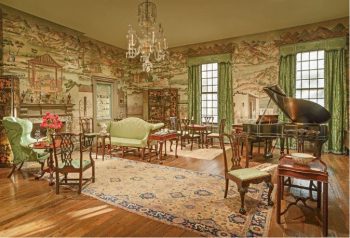By Vidya Rajan, Columnist, The Times
 Last week, I visited Connecticut. Walking in Hammonasset Beach State Park, I came across a bunch of birders all excited for the migratory birds that they were spotting. One of the birders and I got talking and told me he was an art restorer at Yale University.
Last week, I visited Connecticut. Walking in Hammonasset Beach State Park, I came across a bunch of birders all excited for the migratory birds that they were spotting. One of the birders and I got talking and told me he was an art restorer at Yale University.
This was very exciting for me, because I really love to read about how artists created pigments. For example, the still-bright blue 2,000-year-old murals of Ajanta Caves in India was made by crushing the semi-precious stone, lapis lazuli, sourced from Afghanistan. Tyrian red (made from an aquatic snail) was so expensive that only Senators and Emperors in ancient Rome were allowed to wear it.
Indigo was another rare and luxurious product sought after in ancient Greece and Rome which was sourced from the Indigofera tinctoria plant which had been domesticated and cultivated in India (hence the name). And green – so abundant in plants and such a restful color – was made from copper carbonate or by crushing the green mineral, malachite. In 1775, Carl Wilhelm Scheele synthesized Scheele’s green, a bright green pigment composed of cupric hydrogen arsenite, CuHAsO3. It had a lovely yellow-green color and became resoundingly popular because it was more durable than copper carbonate. So popular, in fact, that “[by] the end of the 19th century, it had virtually replaced the older green pigments based on copper carbonate”.[1] In1814, another even more vibrant, emerald-green pigment, Paris green, was made from copper and arsenate (Figure 1). Both Scheele’s green and Paris green found a second use as rat poison and insecticide, which tells you something of their toxic nature.

Figure 1: Left: Two modern non-toxic color variations of Scheele’s green (the pigment on the left – Hex #478800 – is considered more representative of the original color) and Paris green; Right: Exposure limits for Scheele’s green with a recommended maximum exposure of about 2 micrograms/cubic meter in 15 minutes. Paris green has a similar exposure limit. Information obtained under Fair Use from References 1 and [2].

Figure 1: The Chinese Parlor, Winterthur, with hand-painted 18th century wallpaper. From: https://www.winterthur.org/calendar/objects-up-close-virtual-series-5/
In 2019, conservationist Melissa Tedone found a book in Winterthur’s collection with green binding, but some of the green glue in the book’s binding was flaking off. Upon analysis, laboratory head Rosie Grayburn identified the green pigment colorizing the glue to be the arsenical compound, Paris green (Figure 1). The point here is that the toxic chemicals in binding could wear off onto the reader’s hands. The University of Delaware and Winterthur Library and Museum came together to identify such books in the brilliantly named Poison Book Project.[4] Aficionados of period literature will recognize shades of Umberto Eco’s brilliant The Name of the Rose. (Not giving away any more information. Read the book or watch the movie, it’s a riveting old-fashioned detective story set in a dank Italian monastery in 1327). Other pigments, such as chrome yellow (which contains lead) and vermilion (which contains mercuric sulfide) were also identified. As of September 2022, the Poison Book Project had identified 101 books in libraries across the world that contained Paris green.
Lead and arsenic are not confined to old books. Lead pipes in water supply systems still poison, as Flint, Michigan, showed. Arsenic is a daily poison in many parts of the world, such as Bangladesh where soil has high levels of naturally occurring arsenate. Wells drilled willy nilly by well-meaning organizations ended up providing toxin-laced water. Arsenic is a poison because it can substitute for phosphorus in biological molecules. Interestingly enough, people who live in an arsenic-rich environments in Argentina, Bangladesh, Mexico and Taiwan have a protective mutation in a gene called AS3MT, which increases arsenic metabolism to a product called dimethylarsinic acid (DMA) which is readily excreted in urine and thereby removed from the body. I wonder if the painters who slapped Paris and Scheele’s green on all those walls a hundred years ago happened to have those protective gene variants too. If not, they could have died pretty nasty deaths from diarrhea, vomiting, abdominal pain and cancer.
Possibly those who frequented those rooms would have also inhaled some arsenic from the wallpaper. Napoleon I had living in the admittedly decrepit and dank Longwood House on the remote Atlantic island of St. Helena, where he died on 5 May, 1821 at 51 years of age. Jeremy Barnes recounted the following in a personal email:
“Napoleon’s body was exhumed in 1840 by the new Orleans monarchy and returned to Paris, where evidence of arsenic was found in the hair. The first suspicion was that Napoleon had been poisoned by his British doctors on St. Helena, which didn’t exactly improve the strained relations between the French and the British!
He spent the last 6 years of his life in a small room on St Helena, writing his memoirs. The room was lined with a green wallpaper, the color of which was obtained by adding arsenic to the mix. So he probably absorbed enough in that confined space to account for the traces in his hair, but certainly not enough to kill him.
Even so, I and a few others have alleged mischievously that Napoleon survived the biggest armies that Europe could muster only to be killed by his wallpaper!”
[1] Wikipedia Contributors (2022). Scheele. Wikipedia. Available at: https://en.wikipedia.org/wiki/Scheele’s_green
[2] Wikipedia. (2022). Paris green. [online] Available at: https://en.wikipedia.org/wiki/Paris_green.
[3] Gibbs, E.M., 2012. Colors and techniques of eighteenth-century Chinese wallpaper: Blair House as a case study. In: The Materiality of Color: The Production, Circulation, and Application of Dyes and Pigments, 1400-1800, p.247.
[4] Wikipedia Contributors (2025). Poison Book Project. Wikipedia. https://en.wikipedia.org/wiki/Poison_Book_Project




